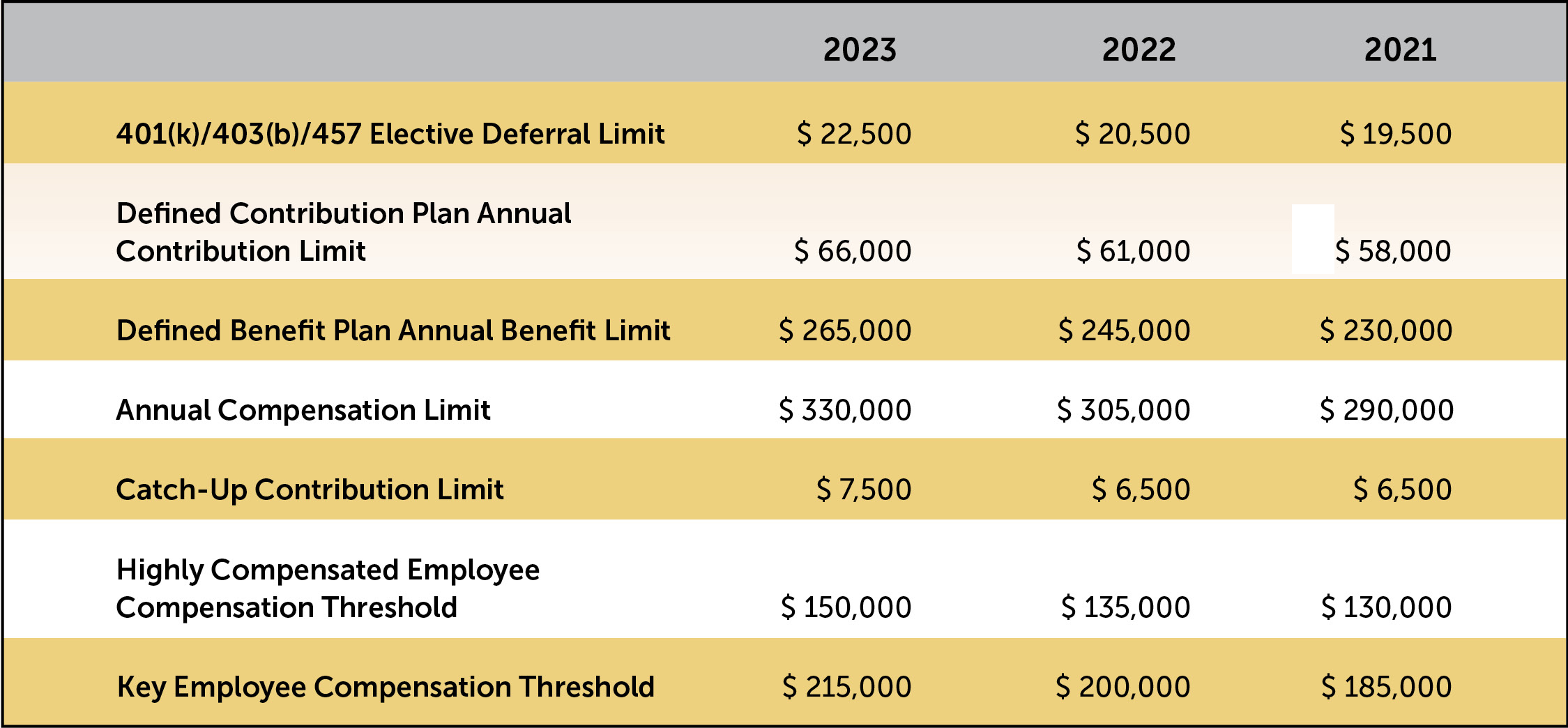SHANNON OLIVER, November 10, 2022
On October 21, 2022, the Internal Revenue Service issued Notice 2022-55, containing the cost-of-living adjustments related to retirement plan limitations under the Internal Revenue Code (the “Code”). These changes will take effect on January 1, 2023. Below are some of the key highlights.
Adjusted Limitations
- The limitation on the annual benefit under a defined benefit plan is increased from $245,000 to $265,000. (Code section 415(b)(1)(A)).
- For a participant who separated from service before January 1, 2023, the participant’s limitation under a defined benefit plan under section 415(b)(1)(B) is computed by multiplying the participant’s compensation limitation, as adjusted through 2022, by 1.0833.
- The annual contribution limitation for defined contribution plans is increased from $61,000 to $66,000 (Code section 415(c)(1)(A)).
- The annual compensation limit is increased from $305,000 to $330,000. (Code sections 401(a)(17), 404(l), 408(k)(3)(C) and 408(k)(6)(D)(ii)).
- The limitation on the exclusion for elective deferrals is increased from $20,500 to $22,500. (Code sections 402(g)(1) and 402(g)(3)).
- The annual compensation limitation for eligible participants in certain governmental plans that, under the plan as in effect on July 1, 1993, allowed cost-of-living adjustments to the compensation limitation to be taken into account, is increased from $450,000 to $490,000. (Code section 401(a)(17)).
- The compensation amount regarding simplified employee pensions (SEPs) is increased from $650 to $750. (Code section 408(k)(2)(C)).
- The limitation regarding SIMPLE retirement accounts is increased from $14,000 to $15,500. (Code section 408(p)(2)(E)).
- The dollar limitation regarding the definition of “key employee” in a top-heavy plan increased from $200,000 to $215,000. (Code section 416(i)(1)(A)(i)).
- The dollar amount for determining the maximum account balance in an employee stock ownership plan subject to a 5-year distribution period is increased from $1,230,000 to $1,330,000, while the dollar amount used to determine the lengthening of the 5-year distribution period is increased to $265,000, up from $245,000 in 2021. (Code section 409(o)(1)(C)(ii)).
- The limitation used in the definition of “highly compensated employee” is increased from $135,000 to $150,000. (Code section 414(q)(1)(B)).
- The maximum amount of catch-up contributions individuals aged 50 or over may make to 401(k) plans, 403(b) plans, SEPs, and governmental 457(b) plans increased from $6,500 to $7,500. (Code section 414(v)(2)(B)(i)).
- The maximum amount of catch-up contributions that individuals aged 50 or over may make to SIMPLE 401(k) plans or SIMPLE retirement accounts increased from $3,000 to $3,500. (Code section 414(v)(2)(B)(ii)).
- The adjusted gross income limitation under Code section 25B(b)(1)(A) for determining the retirement savings contribution credit for married taxpayers filing a joint return is increased from $41,000 to $43,500; the limitation under Section 25B(b)(1)(B) is increased from $44,000 to $47,500; the limitation under Code sections 25B(b)(1)(C) and 25B(b)(1)(D) is increased from $68,000 to $73,000.
- The adjusted gross income limitation under Code section 25B(b)(1)(A) for determining the retirement savings contribution credit for taxpayers filing as head of household is increased from $30,750 to $32,625; the limitation under Section 25B(b)(1)(B) is increased from $33,000 to $35,625; the limitation under Code sections 25B(b)(1)(C) and 25B(b)(1)(D) is increased from $51,000 to $54,750.
- The adjusted gross income limitation under Code section 25B(b)(1)(A) for determining the retirement savings contributions credit for all other taxpayers is increased from $20,500 to $21,750; the limitation under Code section 25B(b)(1)(B) is increased from $22,000 to $23,750; and the limitation under Sections 25B(b)(1)(C) and 25B(b)(1)(D) is increased from $34,000 to $36,500.
- The deductible amount for an individual making qualified retirement contributions is increased from $6,000 to $6,500. (Code section 219(b)(5)(A)).
- The applicable dollar amount for determining the deductible amount of an IRA contribution for taxpayers who are active participants filing a joint return or as a qualifying widow(er) is increased from $109,000 to $116,000. The applicable dollar amount for all other taxpayers who are active participants (other than married taxpayers filing separate returns) is increased from $68,000 to $73,000. The applicable dollar amount for a taxpayer who is not an active participant but whose spouse is an active participant increased from $204,000 to $218,000. (Code Sections 219(g)(3)(B)(i), 219(g)(3)(B)(ii), and 219(g)(7)(A). Note: The applicable dollar amount for determining the deductible amount of an IRA contribution if an individual or the individual’s spouse is an active participant, the applicable dollar amount under section for a married individual filing a separate return is not subject to an annual cost-of-living adjustment and remains $0. (Code section 219(g)(3)(B)).
- Therefore, under section 219(g)(2)(A), the deduction for taxpayers making contributions to a traditional IRA is phased out for single individuals and heads of household who are active participants in a qualified plan (or another retirement plan specified in section 219(g)(5)) and have adjusted gross incomes (as defined in section 219(g)(3)(A)) between $73,000 and $83,000, increased from between $68,000 and $78,000. For married couples filing jointly, if the spouse who makes the IRA contribution is an active participant, the income phase-out range is between $116,000 and $136,000, increased from between $109,000 and $129,000. For an IRA contributor who is not an active participant and is married to someone who is an active participant, the deduction is phased out if the couple’s income is between $218,000 and $228,000, increased from between $204,000 and $214,000. Note: For a married individual filing a separate return who is an active participant, the phase-out range is not subject to an annual cost-of-living adjustment and remains $0 to $10,000.
- The adjusted gross income limitation under section 408A(c)(3)(B)(ii)(I) for determining the maximum Roth IRA contribution for married taxpayers filing a joint return or for taxpayers filing as a qualifying widow(er) is increased from $204,000 to $218,000. The adjusted gross income limitation under section 408A(c)(3)(B)(ii)(II) for all other taxpayers (other than married taxpayers filing separate returns) is increased from $129,000 to $138,000. Note: The applicable dollar amount for a married individual filing a separate return is not subject to an annual cost-of-living adjustment and remains $0. (Code section 408A(c)(3)(B)(ii)(III)).
- Accordingly, under section 408A(c)(3)(A), the adjusted gross income phase-out range fortaxpayers making contributions to a Roth IRA is between $218,000 and $228,000 for married couples filing jointly, increased from between $204,000 and $214,000. For singles and heads of household, the income phase-out range is between $138,000 and $153,000, increased from between $129,000 and $144,000. Note: For a married individual filing a separate return, the phase-out range is not subject to an annual cost-of-living adjustment and remains between $0 and $10,000.
- The limitation on the aggregate amount of length of service awards accruing with respect to any year of service for any bona fide volunteer under section 457(e)(11)(B)(ii) concerning deferred compensation plans of state and local governments and tax-exempt organizations is increased from $6,500 to $7,000.
- The limitation on deferrals under Code section 457(e)(15) concerning deferred compensation plans of state and local governments and tax-exempt organizations is increased from $20,500 to $22,500.
- The limitation concerning the qualified gratuitous transfer of qualified employer securities to an employee stock ownership plan is increased from $55,000 to $60,000. (Code section 664(g)(7)).
- The compensation amount under Code section 1.61-21(f)(5)(i) of the Income Tax Regulations concerning the definition of “control employee” for fringe benefit valuation purposes is increased from $120,000 to $130,000; the compensation amount under Code section 1.61-21(f)(5)(iii) is increased from $245,000 to $265,000.
- The dollar limitation on premiums paid with respect to a qualifying longevity annuity contract under Code section 1.401(a)(9)-6, A-17(b)(2)(i) of the Income Tax Regulations is increased to $155,000 from $145,000 in 2022.
- The dollar threshold the Code utilizes to determine whether a multiemployer plan is a systematically important plan is adjusted using the cost-of-living adjustment. After taking the applicable rounding rule into account, the threshold is increased from $1,220,000,000 to $1,256,000,000. (Code sections 432(e)(9)(H)(v)(lll)(aa) and 432(e)(9)(H)(v)(lll)(bb)).
The following is a quick reference guide to key limitations for 2021-2023.




